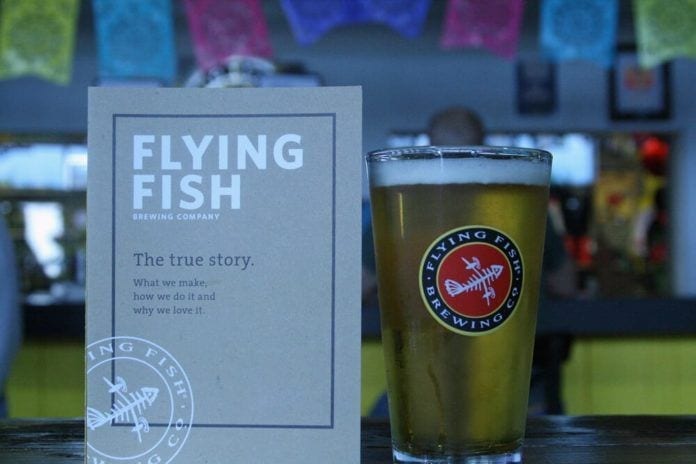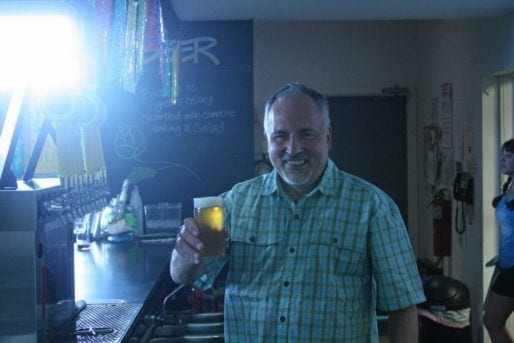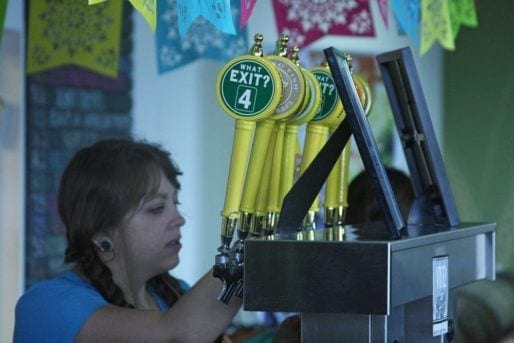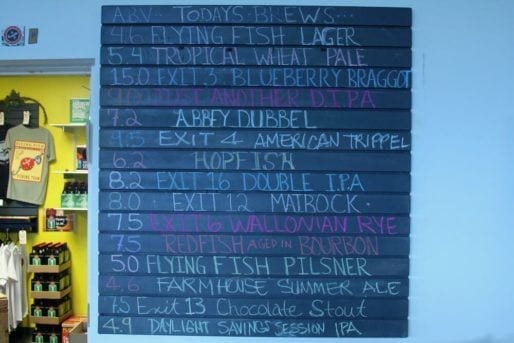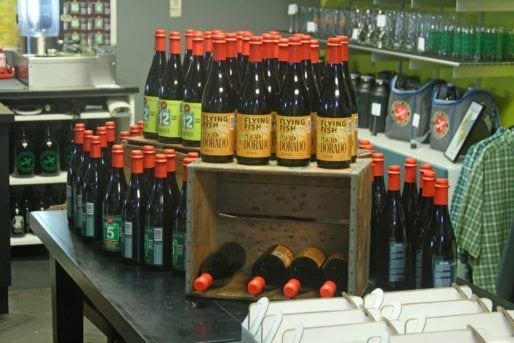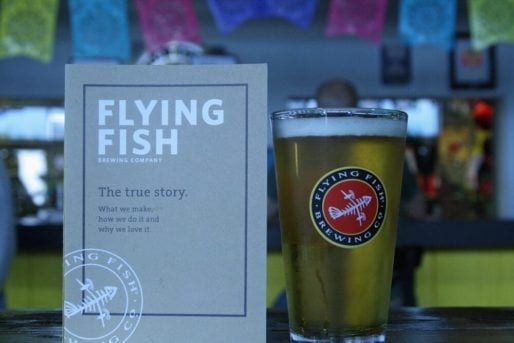If there is a face of the New Jersey craft beer scene, it belongs to Gene Muller of Flying Fish Brewing. With two decades of making Jersey-inspired beer under his belt, Muller shows no signs of stopping. Year-round beers such as HopFish IPA, Extra Pale Ale, Abbey Dubbel and Farmhouse Summer Ale are just as ubiquitous in Jersey as hoagies, toll booths and Sopranos references.
Now, their limited edition Exit series features innovative flavors and styles that showcase the creativity of the Flying Fish brand.
More from Best of NJ
A Lifelong Fan
“I’ve always been fascinated with local beer, whether it be Yuengling, Rolling Rock or Schlitz. When I traveled, I would always stop in a gas station to find out what they drank,” the Jersey-born Muller recounted in the Flying Fish conference room in Somerdale.
“I’ve always loved cooking and finding out how things are made. Then I thought I should make wine, but learned it takes a year to find out if you screwed up. With beer, it’s a quicker turn around.”
Even though homebrewing was illegal at the time, he discovered he was good at it. When it became legal in Jersey in the 80s, he started winning local and national competitions. It was clear that his hobby was overtaking his 9-to-5 day job in marketing. Eventually, he decided to start a Philadelphia-based brewpub restaurant.
“I wrote up a business plan for investors,” he said. “They would all come back to me and say, ‘Let’s get this straight. You’ve never run a business, a brewery or a restaurant, and you want us to invest.’ I said, ‘Yeah!'” After two years of seeking investors, the brewpub concept morphed into a million-dollar production brewery.
In recounting the early history of Flying Fish Brewing, you have to think back to what the internet was like in mid-90s, before web browsers. For early adopters, it was a dial-up modem, an America Online or Prodigy account and a heavy, boxy computer with a VGA graphics card. Muller would chronicle the step-by-step process of brewing, post recipes and give a progress report on message boards and blog-like posts in a makeshift “virtual brewery.”
Ahead of the Game
With the mantra “sometimes it’s better to be lucky than good,” the attention from his virtual brewery in 1994 gained momentum and he was able to set-up FlyingFish.com even before there was such a thing as internet access. He would invite local media to his house to show them what the World Wide Web was all about.
While Muller was learning along the way on how to start a full-scale production brewery, the bigger question remained — what was he going to brew? “I wanted to make sure that the beer would pair well with food, similar to how people pair food with wine,” he explained.
Back in the 90s, the styles of beer known to the public were ales, lagers, pilsners and the occasional stout. When Flying Fish Brewing started shipping out in fall of 1996, bar owners were trying to understand what the Abbey Dubbel was or why the IPA was hazy looking.
“People couldn’t find Belgium on a map let alone understand Belgian beer styles,” he remembered. “Now, it’s completely different, but back then it was a hard sell.”
Refusing to Quit
The 90s craft beer boom eventually fizzled out when investors looking for a get rich quick scheme lost interest when the public wasn’t catching on. While area names like Victory, Yards, Iron Hill, Troegs and Dogfish Head along with Flying Fish Brewing thrive today, just as many went out of business and were written off as a fad.
Muller also believes that the beer just didn’t taste good. Thus, he’s been constantly tweaking recipes and altering the brewing the process in the years since to create a quality product.
Fast forward to this decade, the interest in craft beer resurfaced with foodie culture, social media and the desire to eat and drink locally. With fellow members of the Garden State Craft Brewers Guild, Muller lobbied for legislation to make it easier to open a brewery in the state and to set up tap rooms. Because of his efforts, New Jersey is experiencing its current beer renaissance.
When the law went into effect in 2012, Flying Fish was already planning to move from their original factory in Cherry Hill to their current facility in Somerdale. This allowed them to build a large tap room, install environmentally-friendly energy sources, expand production to about 30,000 barrels a year and explore more sophisticated beers, like their Exit series. This is a reaction to the craft beer enthusiast, who is searching for more unique, hard-to-find brews.
While HopFish IPA, RedFish and Farmhouse Ale remain in the rotation and are amazing go-to beers for any occasion, it’s the NJ Turnpike-inspired Exit series that creates excitement for fans and beer geeks.
What’s on Tap
The one that gained a lot of buzz was Exit 7, the pork roll porter that has breakfast food-like tastes of maple syrup, smoked meats, spices and chocolate. For more chocolate goodness, Exit 13 is their chocolate Irish stout, using Belgian chocolate to give a rich, candy bar-like feel.
For those who want to get buzzed, Exit 3 is a blueberry braggot (a type of mead) that clocks in at an intense 15% ABV, so drink it in small quantities to savor the deep berry flavor.
On the opposite end of booziness is Exit 6 – Wallonian Rye. It’s a multi-cultural concoction that uses Japanese, Slovenian and British hops to make a Belgian style ale that pays tribute to area Dutch settlers.
Flying Fish was one of the first breweries to experiment with barrel-aging theirs beers. Often utilizing barrels from wine, tequila, bourbon and whisky, you’ll find their current offering Pescado Dorado, which ages in Jose Cuervo barrels.
It gives people more reason to visit the Somerdale tap room to see which barrel-aged beers are being served up or bottled. “For me, barrel-aging is what makes beer fun. It blurs the line between beer, wine and spirits,” Muller said. “Each beer in the Exit series has a unique story.”
Unfortunately, the Flying Fish name doesn’t have an elaborate story. The thinking was to not make it specific to New Jersey, but to riff on an animal. Ideas were spitballed around until Muller decided on Flying Fish and the skeleton logo to give it an edge. It can get confusing at beer festivals when they are between Delaware’s Dogfish Head and Maryland’s Flying Dog.
Flying Fish Today
The Flying Fish facility keeps up with innovations by installing environmentally-friendly practices; including utilizing natural lighting, solar panels, irrigation for the native plants, and recycling rain water.
“I’ve always been a firm believer in protecting the environment,” Muller said. “Beer is a food product. If we don’t have good soil for the barley, clean air and clean water, then the beer won’t be great.”
Muller and Flying Fish keep busy making sure they are producing some of Jersey’s most inventive and satisfying beers around. “We’ve been around for 22 years, but there are days it feels like 222 years, others days it feels like 2 years,” he joked. “Even though I work late every day, I can still have my beer at the end of the day and say I’m doing quality control.”
Missed the last installment of Brew Jersey? Read all about Tuckahoe Brewing Co. Don’t forget to check out the entire Brew Jersey series here.
Name: Flying Fish Brewing Co.
Location: Somerdale, Camden County
Standout Beer: HopFish IPA
Know Before You Go: Taproom open for pints, flights, growler fills, bottles to-go, kegs and merchandise. Check Facebook or Untappd for tap lists, updated hours, bottle releases and upcoming events. They allow both food and pets.
All Photos: © Chris Castellani / Best of NJ


